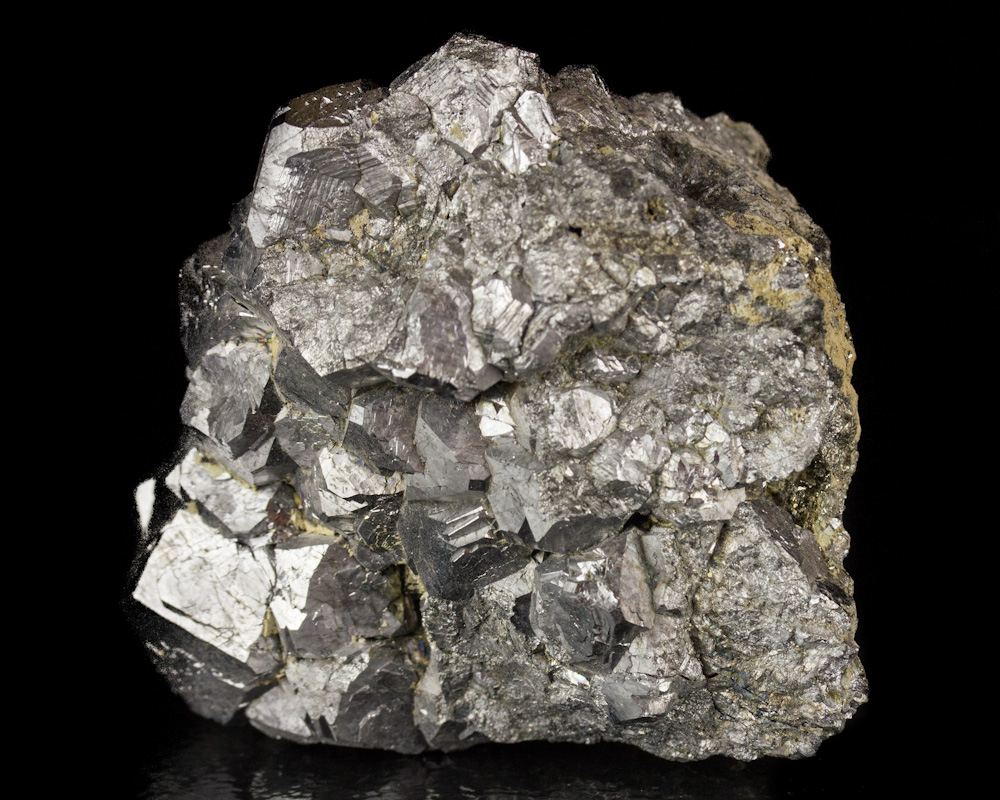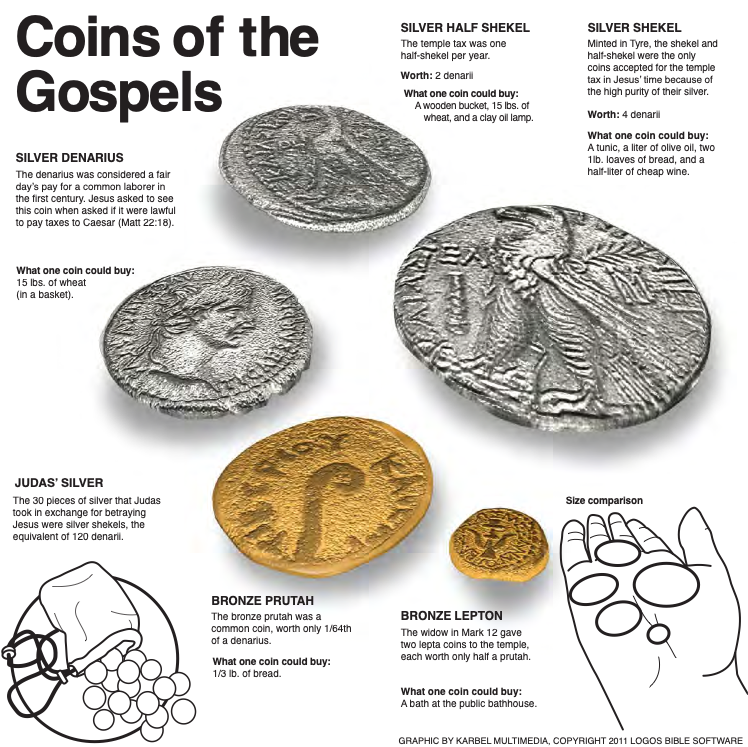
Silver
Silver (Heb. keseph), a pale, precious metal capable of being hammered or drawn out thin, was known to people in the Near East as early as 3000 BCE. (3) A comparatively scarce precious metal with brilliant white color and remarkably resistant to oxidation. It melts at 960.8° C (1,861° F) (4)
Silver mining and metallurgy were known and practiced by craft workers at Ebla (Tell Mardikh in Syria). Some Ebla texts show the value of cattle in silver and list silver as tribute from Mari, recording in one instance 2,188 minas of silver (1 mina equals 47 grams). Silver bars, daggers, adze heads, and small ceremonial shovels are in evidence from biblical times, as are pieces of jewelry and amulets. Silver was used as a standard for business transactions and as a measure of wealth. Excavations at Ur of artifacts from ca. 2500 BCE show Sumerian use of silver for musical instruments, pipes, statuettes, and filigree jewelry. The source of silver in antiquity was probably western Asia Minor and particularly the islands of the Aegean. The Laurion mine near Athens was in use by 1000 BCE as a source of silver. Spain’s Rio Tinto silver mines were likely the source of silver for Phoenician and Roman coinage. Among the most recent archaeological findings in Jerusalem is a small silver scroll bearing text that includes God’s name in Hebrew. The scroll dates to the sixth century BCE. (2)
The first biblical reference to silver from among the approximately four hundred (361 in the NET) Bible passages from Genesis to Malachi is Genesis 13:2, where Abraham’s possession of silver along with his cattle and gold mark him as a wealthy man. He purchased the burial cave at Machpelah from Ephron the Hittite for four hundred shekels of weighed silver (Genesis 23:16). Joseph, the Hebrew in Pharaoh’s court (ca. 1750 BCE), had a silver cup that he placed in his brother Benjamin’s sack (Genesis 44:2, 5, 12, 16). Later he gave Benjamin “three hundred shekels of silver” (Genesis 45:22). As early as the period of the judges (ca. 1200–1000 BCE), the Israelites knew of silver craftsmanship; Judges reports that Micah’s mother took eleven hundred pieces of silver to a silversmith for fashioning an idol (Judges 17:1–6) (2)
Other passages refer to silver used for foundations (1), decorations, vessels for worship, and trumpets for the tabernacle (Exodus 26:19; 27:10, 17; 36:24, 26; Numbers 7:13, 14; 10:2), and in connection with the Jerusalem temple and its treasury (1 Kings 7:51; 1 Chronicles 28:15, 16; 2 Chronicles 2:7; Ezra 8:26, 28; Nehemiah 7:71). Silver was known in the raw state (1 Kings 15:15; Exodus 31:4; 35:24, 32) as well as mined (Job 28:1) and refined (Proverbs 10:20; 1 Chronicles 29:4; Malachi 3:2, 3; Ezekiel 22:20). Long before coinage, silver was known as a standard of wealth (Genesis 13:2; 24:35; Exodus 25:3; Numbers 22:18) and was weighed out for payment of an obligation in measures such as the shekel, talent, and mina (Genesis 20:16; Exodus 21:32; Leviticus. 27:16; Joshua 24:32). Silver was used for special articles of value or prestige, such as a royal crown of silver and gold (Zechariah 6:11), jewelry given to Rebekah (Genesis 24:53), booty received from Egyptian women (Exodus 3:22), and silver-studded ornaments for Solomon’s bride (Song of Soloman 1:11). By contrast, silver was often material for idols as early as the exodus and Judges and as decried in the prophets (Exodus 20:23; Judges 17:4; Isaiah 2:20; Jeremiah 10:4; Daniel 2:32, 33; Hosea 13:2). (2)

Silver’s Value
In the literal sense, silver was used in the ancient Near East both as currency and as an expensive material for making jewelry and decorations in buildings. Beginning in Genesis, Abraham was blessed with a great deal of silver, gold, and livestock; he used silvery as currency in his dealings with merchants and rulers (Genesis 13:2). God commanded the Israelites to plunder their neighbors’ silver and gold as they left Egypt (Exodus 11:2). Thus from the very beginning of the nation of Israel, God blessed his people with wealth. Throughout the Bible, though, silver as a symbol of wealth became a stumbling block for the Israelites, and the kings’ use of silver became a fairly accurate indicator of the state of their hearts and their spiritual position before God. (3)
In the Old Covenant silver is also used as a symbol for all that is precious. Job declares that wisdom is more precious than gold or silver because gold and silver can be discovered and mined but wisdom cannot be easily found (Job 28:1, 15). The writer of Proverbs likewise says that wisdom should be sought as silver or hidden treasures, because it will bring more blessings to the person who possesses it than silver ever could (Proverbs 2:4; 3:14). The psalms declare that the promises of God are precious because they are as pure as “silver refined in a furnace on the ground, purified seven times” (Psalms 12:6 NRSV). (3)
What the righteous say is like the best silver, but what the wicked think is of little value. (Proverbs 10:20 NET)
Signifying both currency and treasure, silver is a natural symbol for wealth and for what is precious. It also pictures a process of refinement that results in something pure. Often the word occurs along with gold to signify great wealth (more than five dozen references). References to silver can be either positive or negative, depending on the attitude with which those who deal with the silver have used it. In all cases, silver is considered beautiful and rare and as such valuable, but the Bible’s distinction between true and false notions of value is relentless. (3)
Silver Reveals the Condition of a Person’s Heart
In the OT both good and bad uses were made of silver, and how a leader used his silver was an indication of the state of his heart before God. The tabernacle was constructed using silver as decoration, and later Joshua placed all the silver and gold from his conquests into the treasury of the Lord (Exodus 26:19; Joshua 6:19). However, during these conquests Achan committed the first sin involving spoils of war: instead of donating them to God or burning them, he stole silver and other plunder and hid them in his tent, for which God punished him by commanding that he, his family and the plunder be stoned and then burned. Achan’s sin was not an isolated event, for by the time of the judges Israel was already making molten images of silver idols (Judges 17:4). Such incidents were to mar Israel’s history as long as it was a nation. (3)
Silver as an image of temptation appears as early as the story of Joseph when his brothers sell him to the Midianite traders for twenty pieces of silver (Genesis 37:28). Later Joseph ironically shows his brothers their sin by placing a silver cup in Benjamin’s satchel and accusing them of stealing it (Gen 44:2). God understood the danger of the gold and silver with which he hoped to bless Israel and therefore warned them repeatedly against becoming ensnared by it. In his eyes, the lust for wealth and the making of graven images were inextricably related. As the children of Israel left Egypt, he commanded, “You shall not make gods of silver alongside me” (Exodus 20:23 NRSV). When the nation entered the Promised Land, God commanded them to burn all idols, saying, “Do not covet the silver or gold that is on them and take it for yourself, because you could be ensnared by it” (Deuteronomy 7:25 NRSV). Likewise, he forbade the king to acquire for himself gold or silver in great quantity (Deuteronomy 17:17). (3)
For a short period under David’s reign, silver was used properly. David placed all the silver from his conquests in the temple treasury, saving it for the building of the temple under his son’s reign (1 Kings 7:51). For his faithfulness and that of Solomon in building so lavish a temple, God rewarded Solomon with riches. (3)
The king made silver as plentiful in Jerusalem as stones; cedar was as plentiful as sycamore fig trees are in the lowlands. (1 Kings 10:27 NET)
During Solomon’s reign “the king made silver as common in Jerusalem as stones” (1 Kings 10:27 NRSV), and all his drinking vessels were of gold, “none were of silver—it was not considered as anything in the days of Solomon” (1 Kings 10:21 NRSV). (3)
However, silver was used wickedly under later kings such as Omri, who “did more evil than all who were before him” (1 Kings 16:25 NRSV), using silver to buy land to build Samaria, a city he dedicated to idolatry. Ahaz, another evil king, used the silver and gold from the house of the Lord to pay tribute to the king of Assyria, who was threatening to invade Israel because Israel had displeased God (2 Kings 16:8). Because Israel was so disobedient in its use of wealth, God prophesied that he would take that wealth away. Ezekiel predicted that Israel would “fling their silver into the streets” because “their silver and gold cannot save them on the day of the wrath of the Lord,” wrath that comes because this silver “was the stumbling block of their iniquity … in which they took pride” and out of which “they made their abominable images” (Ezekiel 7:19–20 NRSV). The Lord also criticized his people for a lack of thankfulness, saying that Israel “did not know that it was I who gave her the grain, the wine, and the oil, and who lavished upon her silver and gold that they used for Baal” (Hosia 2:8 NRSV). (3)
The New Covenant also mentions silver idols (Acts 17:29; Revelation 9:20). In the book of Acts, shrines to Artemis of Ephesus were made by Demetrius the silversmith, who feared Paul’s preaching in the city would destroy his business (Acts 19:23–27). The majority of references to silver in the New Covenant, however, are to silver money. Jesus tells his disciples not to take any silver (or copper or gold) in their belts when they go out as missionaries (Matthew 10:9). In the book of Acts, some magic books burned by Christians at Ephesus are said to have been valued at fifty thousand pieces of silver (Acts 19:19). (2)
Examples of greed and foolishness with money also appear in the New Covenant. Ananias and Sapphira sold a piece of property, giving part of the money to the church with the claim that it was the full amount (Acts 5:1–11). For their sin, God struck them dead before all the people as a warning. In keeping with this forbidding of greed, James warns rich believers not to keep their silver for themselves and in so doing rob their laborers, for if they hoard their wealth they will be deprived of eternal reward (James 5:3). Thus both OT and NT contain examples of how silver can ensnare human hearts. (3)

In what is perhaps the Bible’s best-known reference to silver, Judas receives thirty pieces of silver for his betrayal of Jesus.
Then one of the twelve, the one named Judas Iscariot, went to the chief priests and said, “What will you give me to betray him into your hands?” So they set out thirty silver coins for him. From that time on, Judas began looking for an opportunity to betray him. (Matthew 26:14–16 NET)
Most scholars think that this refers to thirty shekels. A shekel was a silver Judean coin minted according to a standard unit of weight. Each coin contained one shekel (approximately 14.5 grams) of silver. Such a coin was worth about four drachmae (or four denarii) and one drachma (or one denarius) were the typical day’s wage paid to an average worker. (2)
Later Judas had “worldly sadness” about the consequences of his actions and threw the silver on the temple floor (Matthew 27:3-9. 2 Corinthians 7:10).
Then what was spoken by Jeremiah the prophet was fulfilled: “They took the thirty silver coins, the price of the one whose price had been set by the people of Israel, and they gave them for the potter’s field, as the Lord commanded me.” (Matthew 27:9–10 NET)
If the ox gores a male servant or a female servant, the owner must pay thirty shekels of silver, and the ox must be stoned. Exodus 21:32 NET
Thirty pieces of silver were considered just compensation to be paid to the owner of a slave if someone’s ox accidentally killed that slave. The chief priests offered Judas the price for a slave as recompense for their plans to “gore” Jesus the Messiah with nails on the Cross of Calvary. (2)
Silver as a Symbol for Purification
Figuratively, silver and the refining process are used to show the testing of people’s hearts (Psalms 66:10; Isaiah 48:10), great abundance (Zechariah. 9:3; Isaiah 60:17; Job 3:15; 22:25; 27:16), and either, positively, the brightness of a dove’s wings (Psalms 68:13) and the purity of God’s word (Psalms 12:6) or, negatively, the corrosive deterioration of God’s people (Jeremiah 6:30; Isaiah 1:22).
The Old Covenant frequently uses the smelting of silver as a metaphor for the purification of people’s hearts through trial. God condemns Israel because its “silver has become dross” (Isaiah 1:22 NRSV). As a result, God refines her “in the furnace of adversity” (Isaiah 48:10 NRSV). Jeremiah is far less hopeful about the results of the refining process. He declares, “In vain the refining goes on, for the wicked are not removed. They are called ‘rejected silver,’ for the Lord has rejected them” (Jeremiah 6:29–30 NRSV).
The NT speaks in similar terms of the refining fire that will reveal the deeds of the righteous in the end times. On the foundation of Jesus Christ, the builder builds with “gold, silver, precious, stones, wood, hay, straw.… If the work is burned up, the builder will suffer loss; the builder will be saved, but only as through fire” (1 Corinthians 3:12, 15 NRSV). Second Timothy 2:20,21 declares that every church contains both righteous and unrighteous believers (utensils of gold and silver and of wood and clay), but “all who cleanse themselves” of sin can become utensils of silver set aside by God for special use, “ready for every good work” (NRSV). Unlike less-cleansed believers, who are compared to utensils of wood and clay, fit for ordinary use. God thus represents his people as silver that must be refined by trials (1) to make them truly pure and righteous. (3)(2)
The value of silver is often belittled in the New Testament by way of comparison with what is spiritual. In Acts, Peter tells a man who is lame that he has no silver (or gold), but is able to offer him something much more valuable: healing in the name of Jesus (Acts 3:6). Wealth measured in silver corrodes and corrupts (James 5:3) and brings only weeping instead of joy (Revelation 18:22). But there is also recognition of the value of silver. Paul refers to different sorts of foundations upon which people might build: gold, silver, precious stones, wood, hay, straw (1 Corinthians 3:12)—silver appears to represent the second-best of the possibilities. (2)
The Typological Meaning of Silver

Approaching the outer court of the Tabernacle of Moses, one would see the bright white linen (1) symbolically representing God’s high standard of purity or righteousness (Revelation 19:8) and would be convicted of sin (Romans 3:23). The outer fence of the Tabernacle had bronze (1) posts (representing God’s judgment due because of our sin) placed on top of the soil (representing all humanity, Genesis 2:7). The silver on the top of the posts represents there is a “price on our head” for redemption that must be paid (Numbers 18:16. Exodus 30:16) to make us righteous (Romans 3:24-26). Our ability to become righteous once this price is paid by the blood of Jesus (1) (symbolically represented by the silver hooks supporting the white linen) and able to escape the fiery judgment that we deserve (symbolically represented by the bronze post and base Numbers 21:8,9). That is, the message of sin, righteousness, and judgment is conveyed to anyone approaching the Outer Court via the materials and construction of the Outer Court’s fence or wall (John 16:8-11). The wall’s message – which represents the law – you must be perfect for entering the Tabernacle Complex and approaching a Holy God! The only way to become perfectly righteous is to accept Jesus as Lord and Savior (1)

The value and use of silver as currency are so great in the biblical imagination that it typologically represents the price that must be paid for the redemption of mankind’s sin so as to escape God’s judgment! The readers of First Peter are reminded that they were not ransomed from their futile ways with perishable things like silver or gold, but with the precious blood of Christ (1).
You know that from your empty way of life inherited from your ancestors you were ransomed—not by perishable things like silver or gold, but by precious blood like that of an unblemished and spotless lamb, namely Christ. (1 Peter 1:18 NET)
Jesus the Messiah has once and for all time paid the redemption price for all that will call upon His name (1)!
For this is the way God loved the world: He gave his one and only Son, so that everyone who believes in him will not perish but have eternal life. For God did not send his Son into the world to condemn the world, but that the world should be saved through him. The one who believes in him is not condemned. The one who does not believe has been condemned already, because he has not believed in the name of the one and only Son of God. (John 3:16–18 NET)
Biblical Typologies, Metaphors, & Similes Series:
- The Old Leaven of the Kingdom of Darkness
- The New Leaven of the Kingdom of Heaven
- Wine
- Water
- Finely Sifted (Wheat) Flour
- Frankincense
- Myrrh
- Anointing Oil
- Olive Oil
- Honey
- Salt
- Waving and Heaving
- Barley
- Gold
- Silver
- Bronze
- Stone
- Wood
- Linen
- Iron
- Shofar and Trumpet
Shalom
(Security, Wholeness, Success)
Peace
Then he said to them, “Therefore every expert in the law who has been trained for the kingdom of heaven is like the owner of a house who brings out of his treasure what is new and old.” (Matthew 13:52 NET)
(1) Select the link to open another article with additional information in a new tab.
(2) Coughenour, R. A. (2011). gold. In M. A. Powell (Ed.), The HarperCollins Bible Dictionary (Revised and Updated) (Third Edition, pp. 962-963). New York: HarperCollins.
(3) Ryken, L., Wilhoit, J., Longman, T., Duriez, C., Penney, D., & Reid, D. G. (2000). In Dictionary of biblical imagery (electronic ed., pp. 791–792). Downers Grove, IL: InterVarsity Press.
(4) Matthews, L. (2003). Silver. In C. Brand, C. Draper, A. England, S. Bond, E. R. Clendenen, & T. C. Butler (Eds.), Holman Illustrated Bible Dictionary (p. 1503). Nashville, TN: Holman Bible Publishers.





One Comment
sonshine
Why is it that I never connected this? Later Joseph ironically shows his brothers their sin by placing a silver cup in Benjamin’s satchel and accusing them of stealing it (Gen 44:2)
Thanks for this very informative and interesting blog post!
Gaye